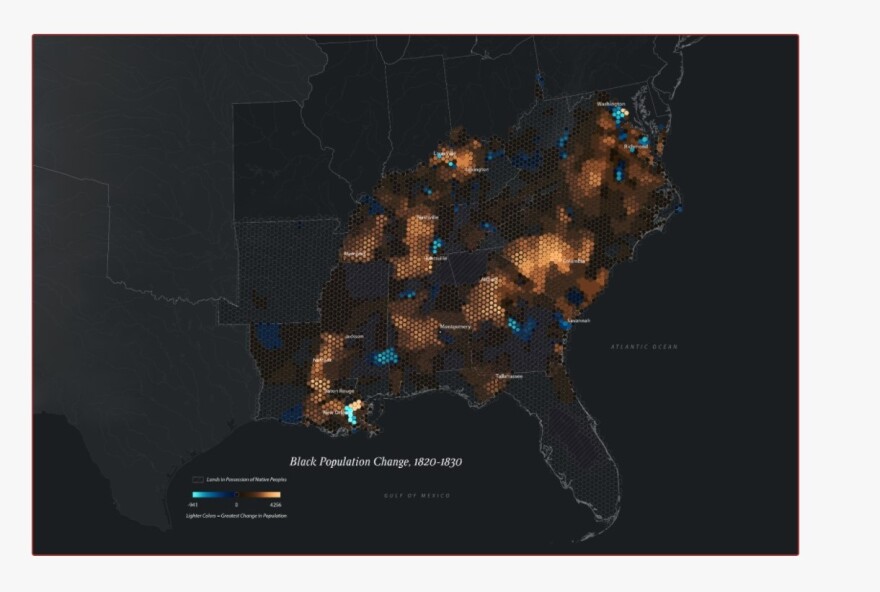
Studying the history of Southern migration is a great way to understand the history of the nation – that’s according to author and historian Ed Ayers. His new book is filled with hundreds of detailed maps that demonstrate just how diverse the South is by tracking the comings and goings of people since before the birth of the country. Ed Ayres is our speaker for WMRA's virtual Books & Brews on November 12, 2020. WMRA’s Chris Boros spoke with Ed by phone and he asked Ed to describe the importance of Southern migration.
Ed Ayres: People often picture the South as a place where people don't migrate - it being a relatively fixed place. So I (wrote the book) because it seems to explain a lot of what's otherwise hard to explain about the south.
WMRA: What do you think you were able to explain about the south from this book?
EA: First of all, you have to see the book which is pretty remarkable. It has 200 maps and the maps are a kind that have never been made before. They show where white people and black people and Native people and immigrants increase and decrease every decade. What made the South was the migration from Virginia and the Carolinas all the way to Texas in really short period of time. So if you want to talk about the sound, it’s created by migration. I think people know about the domestic slave trade, but then we see the remaking of the South. What happens when the largest system of slavery in the modern world is destroyed overnight? A lot of black people move to the Deep South from places like, Virginia, where there's not really a good way to make a living here. We see the great migration of white and black Virginians basically fleeing the South for several generations. And then we see what we're experiencing today, which is for the first time in history, the south is a magnet for people from all over the country and all over the world.

WMRA: A review of your book mentions how human movement is one of the most powerful ways to understand Southern history, and I wonder if you could expand on that a little?
EA: Yeah, I think everything from country music to sort of popular novels, the South is basically understood as a place where things don't happen. But in fact the South has been as ruthless as the rest of the United States. People have moved in the South as much as they have everywhere else. So it's a remarkably tumultuous story.
WMRA: How did you go about researching this book?
EA: It's interesting because my friends at the digital scholarship lab at The University of Richmond had devised this method of mapping people's movements that nobody's ever devised before. And I saw that and I said, well it is great. Would you all be willing to do this for 230 years and they said yes. So when you look at the maps you see areas smaller than counties where people are leaving and people were arriving ann the patterns are remarkably striking when people see the book their mouths just drop open because they've never seen anything like that. So then I had to go and explain all these patterns. Why was this area seeing so many people arrive or so many people leave? And since I had to figure out all of white migration, all of black migration, and all of the indigenous migration, and then all of immigrant migration, I had to read like 20 books for every paragraph. So it was one of the harder books I’ve written but it actually makes a pretty powerful story.

WMRA: Did anything surprise you when you were researching this that you were weren't expecting?
EA: Everything, basically. The the patterns are so complicated and I think as a Virginian the thing that surprised me was how quickly black people abandoned Virginia. At the time the nation begins, Virginia is almost 40% African Americans, and today it’s 13%. So how did that happen? And it turns out that Virginia was a place you could actually perhaps escape from - get on a boat down in Richmond or Norfolk, but it was also a place that's pretty close to Philadelphia and New York and Boston as soon as you were free and people fled.
WMRA: You mentioned earlier in this conversation that there are more people than ever migrating to the South. Is that right?
EA: Yeah. It's right. And that what you're finding is that obviously we're used to the idea that Texas and Florida which are deeply southern states have attacked a lot of people but today just think of the belt that basically runs from Central North Carolina down through South Carolina to Atlanta and enormous population movements there and basically to cities is where people are moving. So a lot of rural Southerners, black and white, are moving to town. I think what happened was after the Civil Rights Movement freed the South, the South has begun to flourish.

WMRA: If there is one thing you think we can learn about American history from studying Southern migration, what do you think it is?
EA: People want to keep freezing the South with a certain identity. I think if you look at these maps and think about the story you see the South has constantly been changing, even under slavery, even under segregation, and especially now. So I want people to understand how fully American the southern story is and how fully Southern the American story is.




